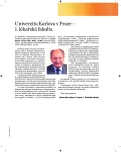Amniotic fluid embolism – review
Authors:
A. Černý; A. Pařízek; Patrik Šimják
Authors‘ workplace:
Gynekologicko-porodnická klinika 1. LF UK a VFN, Praha, přednosta prof. MUDr. A. Martan, DrSc.
Published in:
Ceska Gynekol 2014; 79(4): 255-259
Overview
Amniotic fluid embolism is a rare but mortal pregnancy complication. Presentations may vary from subtle clinical events to sudden cardiac arrest or death. Amniotic fluid embolism is one of the most common cause of maternal mortality in developed countries. Basic principle is amniotic fluid and its particles gaining access to maternal circulation. It is supposed, that these particles trigger immune-based mechanism. This results into wide spectrum of clinical symptoms, especially cardiovascular, respiratory and haematological. Treatment of these symptoms needs an acute interdisciplinary cooperation. AFE mortality is decreasing in recent times. It is mainly because of increase of quality of intensive care and inclusion of less severe episodes in perinatal pathology registries.
Keywords:
amniotic fluid embolism, anaphylactic shock, sepsis
Sources
1. Benson, MD. Current concepts of immunology and diagnosis in amniotic fluid embolism. Clin Dev Immunol, 2012, 2012 : 946576, 7 p.
2. Clark, SL., Hankins, GDV., Dudley, DA., et al. Amniotic fluid embolism: Analysis of the national registry. Am J Obstet Gynecol, 1995, 172, p. 1158–1169.
3. Conde-Agudelo, A., Romero, R. Amniotic fluid embolism: an evidence based review. Am J Obstet Gynecol, 2009, 201, p. 445.e1–445.13.
4. Dobbenga-Rhodes, YA. Responding to amniotic fluid embolism. AORN J, 2009, 89, p. 1079–1088.
5. Firstenberg, MS., Abel, E., Blais, D., et al. Temporary extracorporeal circulatory support and pulmonary embolectomy for catastrophic amniotic fluid embolism. Heart Surg Forum, 2011, 14, p. 157–159.
6. Knight, M., Berg, C., Brocklehurst, P., et al. Amniotic fluid embolism incidence, risk factors and outcomes: a review and recommendations. BMC Pregnancy and Childbirth. 2012, 12, 11 s. http://www.biomedcentral.com/1471-2393/12/7.
7. Knight, M., Tuffnell, D., Brocklehurst, P., et al. Incidence and risk factors for amniotic-fluid embolism. Obstet Gynecol, 2010, 115, p. 910–917.
8. Kobayashi, H., Naruse, K., Sado, T., et al. Search for amniotic fluid-specific markers: novel biomarker candidates for amniotic fluid embolism. Open Women’s Health J, 2011, 5, p. 7–15.
9. Kramer, MS., Rouleau, J., Liu, S., et al. Amniotic fluid embolism: incidence, risk factors, and impact on perinatal outcome. BJOG, 2012, 119, p. 874–879.
10. Legrand, M., Rossignol, M., Dreux, S., et al. Diagnostic accuracy of insulin-like growth factor binding-protein-1 for amniotic fluid embolism. Crit Care Med, 2012, 40, p. 2059–2063.
11. McDonnell, NJ., Percival, V., Peach, MJ. Amniotic fluid embolism: a leading cause of maternal death yet still a medical conundrum. Int J Obstet Anesth, 2013, 22, p. 329–336.
12. Pařízek, A. Embolie plodovou vodou. In Pařízek, A. Kritické stavy v porodnictví. Kamenice: Mother-Care-Centrum Publishing, 2012, s. 108–110.
13. Thongrong, C., Kasemsin, P., Hofmann, JP., et al. Amniotic fluid embolism. Int J Crit Illn Inj Sci, 2013, 3, p. 51–57.
14. Tuffnell, DJ. Amniotic fluid embolism. Curr Opin Obstet Gynecol, 2003, 15, p. 119–122.
15. Tuffnell, DJ. United Kingdom amniotic fluid embolism register. BJOG, 2005, 112, p. 1625–1629.
Labels
Paediatric gynaecology Gynaecology and obstetrics Reproduction medicineArticle was published in
Czech Gynaecology

2014 Issue 4
Most read in this issue
- Amniotic fluid embolism – review
- Prenatal growth curves of the Czech population
- Dysplasia and cervical cancer: current diagnostic possibilities
- Prebioptic methods in the cervical cancer screening
